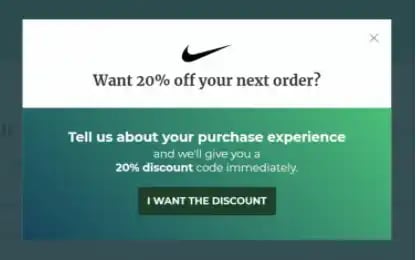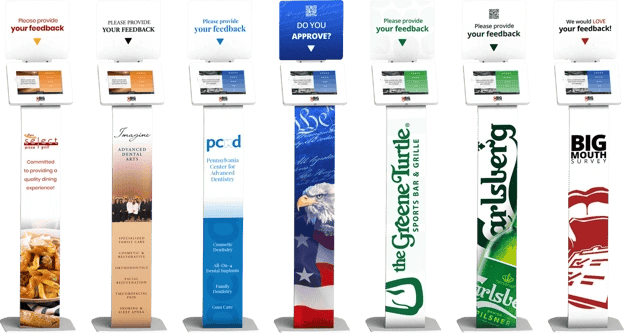It’s no secret that collecting and analyzing customer feedback can be highly valuable for improving your product or service. However, obtaining that feedback can often be a tricky challenge for many businesses. This is because customers are motivated by their goals and deadlines, so it’s not their responsibility to provide your company with feedback.

Many customers are reluctant to fill out surveys or participate in reviews because of the inconveniences these measures cause. Customers have busy schedules, and many won’t have time to waste pointing out your product or service’s flaws. Others may be skeptical of the questions that you’re asking and don't feel comfortable with providing honest information.
When asking for feedback, you must consider the best way to approach your customers. To help, we’ve compiled just a few ways that you can obtain customer feedback:
Customer Feedback Methods
- Monitor social media channels.
- Offer incentives for feedback.
- Host a social media contest.
- Adopt Net Promoter Score.
- Include post-purchase feedback.
- Delay asking for feedback.
- Use feedback monitoring sites.
- Set up a survey kiosk.
- Use heatmaps on your website.
1. Monitor social media channels.
Social media has become an inexpensive and efficient way to communicate with your target audience. Customers are already actively participating in communities on Facebook, Twitter, and Instagram, and it doesn’t cost your business anything to join in on their conversations. Respond to comments, send direct messages, and engage with your audience to see how people really feel about your company.
When your team encounters negative reviews, be sure to respond to them quickly. Active social media users are expecting a fast response, so you have to dedicate a resource to each channel. Closely monitoring your social buzz is a great way to track trends and events that can influence your business.
2. Offer incentives for feedback.
Going through a survey takes away valuable time from a customer’s busy schedule. One way to make your surveys worth the investment is to offer a reward for their completion. This makes for a simple, yet highly effective transaction approach to obtaining feedback.

While money or discounts are great, keep in mind that the reward doesn’t have to be cash, either. You can incentivize customers using free content that’s useful to their workflow. This could be an e-book, an in-house study, or an educational pamphlet that helps them achieve their goals.
3. Host a social media contest.
If there’s one thing customers love, it’s a chance to win something for free.
A great way to collect more feedback is to use your favorite channel to promote a social media contest. In your post, provide a form to collect customer’s opinions and specify in the rules that completion is an entry to win something awesome.
Customers won’t mind taking a moment to fill out a survey, so long as it’s not too lengthy and otherwise tedious for the prize value. And make sure you set concrete start and end dates so you can analyze fresh data and determine the winner promptly.
4. Adopt Net Promoter Score.
Net Promoter Score or NPS® is one of the best ways to obtain and measure customer feedback. It uses a scale of 1-10 to determine whether your customers would recommend your company to other customers. Scores from 0-6 are considered to be negative responses, or “detractors.” Scores between 7-8 are neutral, or “passive.” Finally, scores of nine and ten symbolize positive experiences and are called “promoters.”
The best part of NPS is that it’s efficient for both the customer and the company. The survey uses only one question which makes it easy to record and analyze results. It doesn’t require a lengthy time investment from the customer, and you have a better chance of receiving thoughtful feedback.
5. Include post-purchase feedback.
If you’re running an e-commerce website, it’s important to find out how your customers feel about their user experience. However, sometimes this can be tricky because a survey can distract customers from making a purchase. You don’t want to lose a potential sale because a survey took the lead away from their shopping cart.
You can avoid this by displaying your feedback options after a purchase is made. Once the sale is finalized, the customer will be less distracted and will be more interested in providing feedback. This especially comes in handy with transactions that involve higher amounts of emotional investment, like buying a large appliance.
6. Delay asking for feedback.
While getting immediate feedback is great, it’s more useful when the feedback is thoughtful and accurate. Sometimes it takes time for the customer to develop a complete perspective on their buying experience. If you ask for feedback immediately, you’re only getting their initial feelings and not how the product or service impacted them over time.
If you’re noticing customer feedback seems inaccurate, try waiting a week or two before surveying your customers. You may find that the roadblocks challenging them are long-term problems that occur over the continued use of your product or service.
7. Use feedback monitoring sites.
Instead of directly asking for feedback, you can monitor what people are posting about your company using third-party sites and apps. For example, tools like Google Alerts and Yext can notify you whenever a review is posted about your company on any website. This can help you discover feedback that may be posted in online communities that your customer service team isn’t unaware of. With new internet communities popping up every day, it’s important to have a radar that can monitor your company’s online buzz.
8. Set up a survey kiosk.
If your company is hosting or attending an event, that's an excellent opportunity to ask customers for feedback. One way to start this conversation is to set up a survey kiosk like the ones in the image below.

Survey kiosks are less intrusive than walking up to a customer and asking them to fill out a form. Instead, customers can simply approach the kiosk, fill out the survey on the tablet, then continue on their way without having to interact with a service rep. This gives customers the privacy to provide candid feedback without feeling pressured by one of your employees who may be eagerly awaiting their response.
9. Use heatmaps on your website.
Customer feedback doesn’t necessarily have to be explicit. Your customers’ activity on your website can give you valuable information with the aid of a heatmap.

For a more hands-off approach, collect data from where your customer’s mouse “clicks” most on your website. This allows you to make informed decisions on your website UX and optimization — comparing and contrasting your most clicked sections to parts that are overlooked.
Customer Feedback Grows into Customer Satisfaction
All departments must be involved in customer satisfaction — and that starts with customer feedback. In an economic environment where every business is looking for cost-effective ways to generate customers, there's no end to the value consistent feedback will bring to your teams.


![How to Write a Thank You Letter for Customer Feedback [Templates]](https://knowledge.hubspot.com/hubfs/thank-you-letter-for-customer-feedback-1-20241003-1267887.webp)








![‘How Did You Hear About Us’ Survey Options: All-In-One Guide [+ Examples]](https://www.hubspot.com/hubfs/how%20did%20you%20hear%20about%20us_featured.jpg)